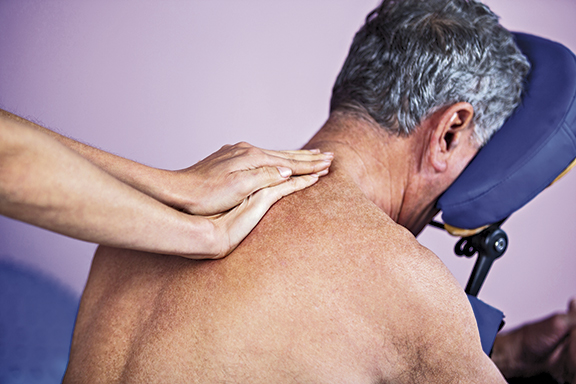By Susan C. Jenkins
What comes to mind when you hear the word “massage”? A relaxing day at the spa? A sleazy storefront in a disreputable part of town? What about geriatric massage? While that’s not the first thing that comes to most people’s minds, it is a practice that may help many of your clients.
What is geriatric massage?
In some ways, geriatric massage resembles a lighter form of Swedish massage, but there are some important differences. Geriatric massage involves using the hands to gently rub the soft tissues to improve blood circulation, relieve pain, and increase range of motion, but it employs specialized techniques designed for aging skin and muscles. Characteristics of geriatric massage include the following:
- Prior to the treatment, the massage therapist should consult with the client’s healthcare team to become aware of any problems that may be encountered during the massage.
- The massage therapist needs flexibility in positioning aging clients. Some clients may not be able to get on or off a massage table easily, and options might need to be explored.
- Body placement is important. For example, someone with respiratory problems should not be placed in a prone position, and the back should be worked with the person in a sitting position or lying on his/her side.
- Long, stripping strokes should be avoided, because skin thins with age. A technique called fluffing, which combines rhythmic stroking and gently lifting and squeezing the skin, may be more appropriate.
- In most cases, stretching techniques should not be used.
- While the focus is on gentle motions, on occasion stronger movements may be needed—for example, to improve flexibility of the shoulders.
- Sessions should be short—usually no more than 30 minutes.
Benefits of geriatric massage
Older people are prone to developing age-related diseases that limit their physical capabilities and cause poor circulation. Geriatric massage can help some people regain certain physical functions and mobility. Additionally, many seniors are lonely, anxious, or depressed, and geriatric massage can provide comfort to touch-deprived elderly clients and improve their quality of life. Other benefits of geriatric massage include:
- Speeding recovery from injury or illness
- Enhancing the length and quality of sleep
- Easing anxiety and improving sensorimotor functions after a stroke
- Reducing the physical signs of agitation (e.g., pacing, wandering, resisting) in Alzheimer’s sufferers
- Improving lymphatic flow, which increases the excretion of toxic substances from the body
There is also some evidence that geriatric massage can have an effect on memory. Repetitive touch can help the elderly—particularly those with Alzheimer’s disease—to retain some body memory, and that in turn can trigger the recall of other memories.
Cautions
In general, geriatric massage is considered safe for most seniors; however, there are some cautions to be aware of.
- Calf pain with heat can be a sign of phlebitis and should not be massaged.
- If a client has a blood clot or an aneurism, a doctor’s permission must be obtained before that client can receive a massage.
- Do not perform deep tissue massage on elderly people, because their skin is thinner and can tear more easily.
- Do not massage:
- open sores, skin ulcers, or burn wounds
- eczema or undiagnosed rashes
- the site of an injury or surgery
- sore, enlarged lymph nodes
Every client is different, and it is important to evaluate each one individually to determine if geriatric massage is an appropriate addition to the care program.
Susan C. Jenkins is a freelance writer and editor specializing in medicine, pharmacy, and healthcare. She can be reached at susancjenkins@gmail.com.


